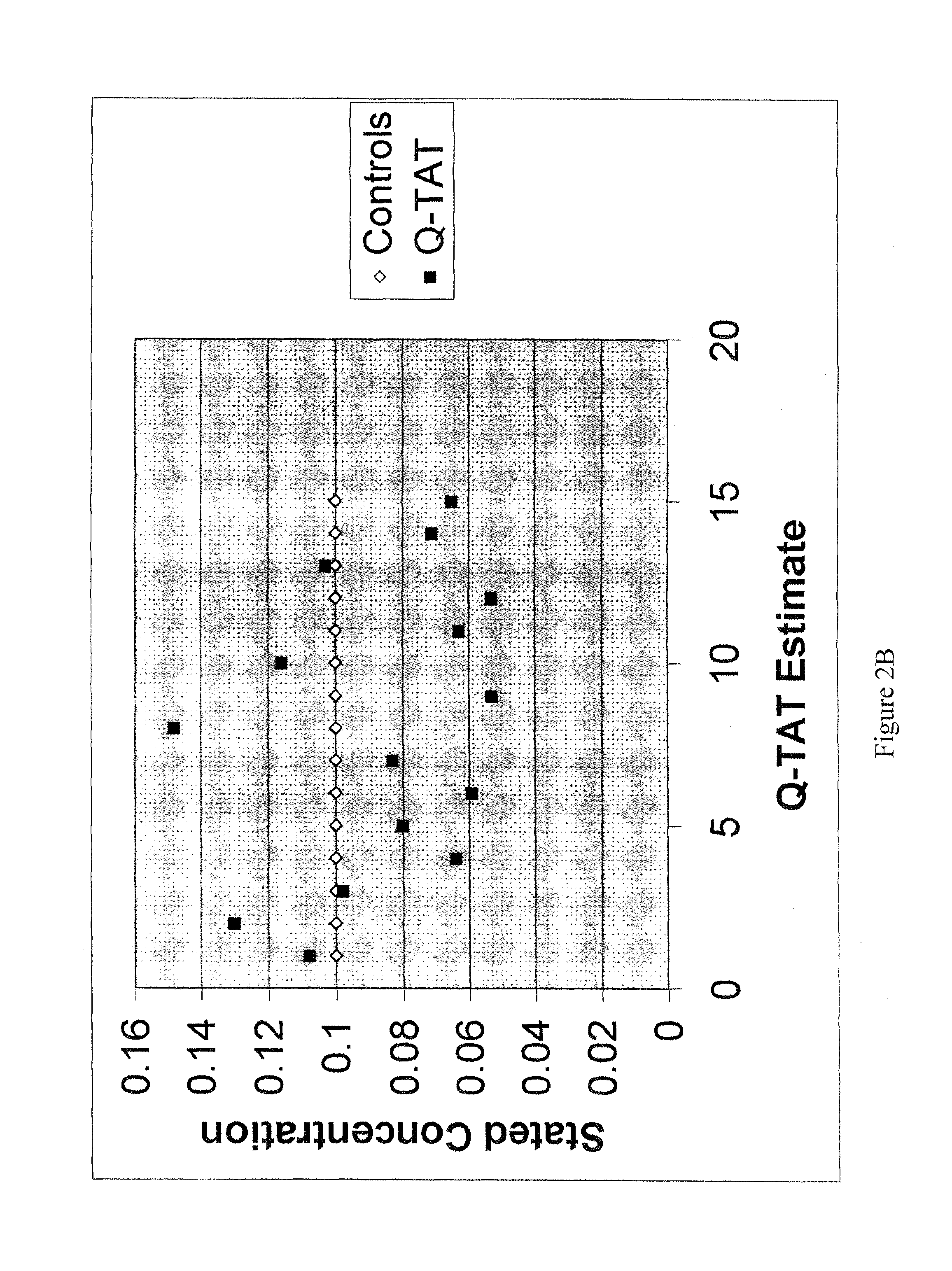Method for simultaneously determining in a single multiplex reaction gender of donors and quantities of genomic DNA and ratios thereof, presence and extent of DNA degradation, and PCR inhibition within a human DNA sample
a multiplex reaction and human dna technology, applied in the field of gene testing, can solve the problem of actual cost of carrying out other similar methods of about $10.00, and achieve the effect of maximizing reliable signals
- Summary
- Abstract
- Description
- Claims
- Application Information
AI Technical Summary
Benefits of technology
Problems solved by technology
Method used
Image
Examples
example 1
REFERENCES FOR EXAMPLE 1
[0076]1. The Perkin Elmer Corporation, AmpFlSTR® profiler plus, PCR amplification kit, user's manual. San Jose, Calif.: The Perkin Elmer Corporation, c1998.[0077]2. Applied Biosystems. AmpFlSTR® identifiler PCR amplification kit, user's manual. Foster City, Calif.: Applied Biosystems, c2001.[0078]3. Kline M C, Duewer D L, Redman J W, Butler J M. NIST mixed stain study 3: DNA quantitation accuracy and its influence on short tandem repeat multiplex signal intensity. Anal Chem 2003; 75:2463-2469.[0079]4. Butler J M. Forensic DNA typing. Biology, technology, and genetics of STR markers. 2nd Edition, Burlington, Mass.: Elsevier Academic Press, c2005.[0080]5. DNA Advisory Board, Federal Bureau of Investigation. Quality assurance standards for forensic DNA testing laboratories. Washington, D.C.: Federal Bureau of Investigation, c2000. Accessible at: http: / / www.fbi.gov / hq / lab / fsc / backissu / july2000 / codis2a.htm#Introduction.[0081]6. Singer V L, Jones L J, Yue S T, Haug...
example 2
Q-ACE Total Human and Male-Only DNA Quantitation Procedure: Combined Q-TAT and Capillary Electrophoresis
[0093]The procedure that follows has been developmentally validated and internally validated by the Tulsa Police Department Forensic Laboratory Biology Section.
Background Information:
[0094]Knowing the approximate human DNA concentration within extracted forensic evidence samples facilitates successful DNA amplification for the purpose of forensic DNA profiling and is mandated by Standard 9.4 of the QAS (Quality Assurance manual). This requirement stems from the fact that forensic DNA evidence is generally of an extremely limited nature and that, whenever possible, at least half of this limited sample should be retained for future re-testing. Accurate quantification methods performed pre-DNA profiling help to ensure that optimal DNA profiling results will be obtained within one round of testing and that the maximum amount of evidence will remain for further testing. The Biology Sec...
example 3
REFERENCES FOR EXAMPLE 3
[0186]1 Allen R W and Fuller V. Quantitation of human genomic DNA through amplification of the amelogenin locus. J. Forensic Sci. 51:76-81 (2006).[0187]2 DNA Advisory Board, Federal Bureau of Investigation. Quality assurance standards for forensic DNA testing laboratories. Washington, D.C.: Federal Bureau of Investigation, 2000. See website located at fbi.gov / hq / lab / fsc / backissu / july2000 / codis2a.htm#Introduction[0188]3 Sifis M E, Both K, Burgoyne L A. A more sensitive method for the quantitation of genomic DNA by Alu amplification. J. Forensic Sci. 47:589-592 (2002).[0189]4 Nicklas J A, Buel E. Development of an Alu based, real-time PCR method for quantitation of human DNA in forensic samples. J. Forensic Sci. 48:936-944 (2003).[0190]5 Alonso A, Marten P, Albarran C, Garcia O. Fernandez de Simon L. Real-time PCR designs to estimate nuclear and mitochondrial DNA copy number in forensic and ancient DNA studies. Forensic Sci. Intl. 139:141-149 (2004).[0191]6 Wal...
PUM
| Property | Measurement | Unit |
|---|---|---|
| concentration | aaaaa | aaaaa |
| concentration | aaaaa | aaaaa |
| radius | aaaaa | aaaaa |
Abstract
Description
Claims
Application Information
 Login to View More
Login to View More - R&D
- Intellectual Property
- Life Sciences
- Materials
- Tech Scout
- Unparalleled Data Quality
- Higher Quality Content
- 60% Fewer Hallucinations
Browse by: Latest US Patents, China's latest patents, Technical Efficacy Thesaurus, Application Domain, Technology Topic, Popular Technical Reports.
© 2025 PatSnap. All rights reserved.Legal|Privacy policy|Modern Slavery Act Transparency Statement|Sitemap|About US| Contact US: help@patsnap.com



